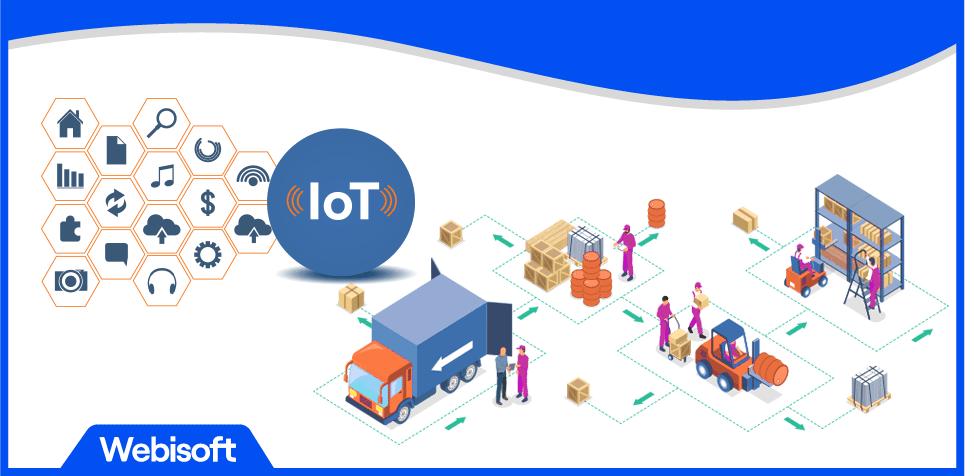The integration of the Internet of Things (IoT) has the potential to revolutionize asset management across industries. Manual tracking methods have often resulted in limited visibility and inefficiencies. However, by leveraging IoT’s seamless connectivity and real-time data insights, you can optimize asset utilization, maintenance strategies, and overall operational performance.
This article about transforming asset management with IoT explores the transformative power of IoT in asset management, showcasing its core components: sensor technology, data connectivity, cloud computing, and advanced analytics. By establishing an interconnected ecosystem, IoT offers real-time visibility, predictive maintenance, improved decision-making, and enhanced asset lifecycle management.
Industries such as manufacturing, logistics, healthcare, and energy have witnessed tangible benefits from IoT-enabled asset management. A recent study found that implementing IoT in manufacturing resulted in a 20% decrease in maintenance costs and a 15% increase in overall equipment effectiveness.
This article aims to provide valuable insights into the significance, working, benefits, and applications of IoT in asset management and monitoring. By addressing key questions, we will explore how your organization can leverage IoT advancements to streamline its operations and maximize the potential of its assets.
Contents
- 1 What Exactly Are Asset Management and Monitoring?
- 2 Why Is IoT Crucial in Asset Management and Monitoring?
- 3 How Do IoT-based Asset Management and Monitoring Differ from Conventional Systems?
- 4
- 5 What Are the Specific IoT Components That Enhance Asset Tracking and Monitoring Processes?
- 6 How Does an IoT-enabled Asset Management and Monitoring Solution Work?
- 7 What Are the Primary Benefits and Advantages of Implementing IoT in Asset Management and Monitoring Practices?
- 8 What Are Some Notable Applications of IoT in Asset Management and Monitoring Across Different Industries?
- 9
- 10 How does IoT Technology Improve Asset Maintenance, Utilization, and Resource Allocation?
- 11 How Can Organizations Adopt IoT Advancements to Streamline Their Asset Management and Monitoring?
- 12 Introducing Websoft: Your Solution for IoT Development
- 13 Final Thoughts
What Exactly Are Asset Management and Monitoring?
Asset management refers to the systematic process of overseeing and optimizing your organization’s assets throughout its lifecycle. It involves acquiring, deploying, operating, maintaining, and disposing of assets in a way that maximizes their value and aligns with your organization’s goals. Assets can include physical equipment, infrastructure, vehicles, machinery, technology systems, and even intangible assets like intellectual property or financial investments.
Monitoring, on the other hand, is the continuous tracking and surveillance of assets to gather real-time data on their performance, condition, location, and other relevant metrics. It involves collecting and analyzing information to ensure assets are functioning optimally, identifying any issues or anomalies, and enabling proactive decision-making regarding maintenance, repairs, or replacement.
The primary objectives of asset management and monitoring are to:
- Maximize asset utilization: Ensuring assets are used efficiently to meet operational needs and generate the highest possible return on investment.
- Optimize asset lifecycle: Managing assets from acquisition to disposal, considering factors such as maintenance, upgrades, and replacement to extend their lifespan and minimize costs.
- Enhance operational efficiency: Streamlining asset-related processes, reducing downtime, and improving productivity through effective planning, scheduling, and resource allocation.
- Ensure regulatory compliance: Adhering to industry regulations, safety standards, and environmental requirements in the management and monitoring of assets.
- Reduce risks and costs: Identifying potential issues, preventing breakdowns, and minimizing unexpected expenses associated with asset failure or inefficiencies.
- Enable data-driven decision-making: Leveraging real-time data and analytics to make informed choices regarding maintenance, investments, asset performance, and overall operational strategies.
By implementing comprehensive asset management and monitoring practices, organizations gain visibility, control, and actionable insights into their assets, enabling them to optimize operations, reduce costs, enhance efficiency, and improve overall business performance.
Why Is IoT Crucial in Asset Management and Monitoring?
IoT (Internet of Things) plays a crucial role in asset management and monitoring due to its ability to revolutionize data collection, connectivity, and real-time insights. Here’s an in-depth look at why IoT is crucial in this context:
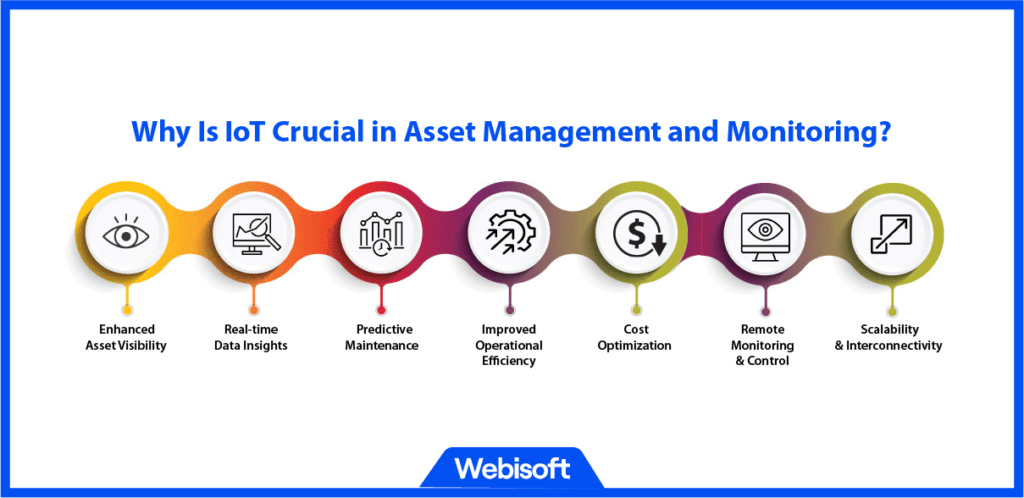
- Enhanced Asset Visibility: IoT provides real-time visibility into asset location, status, and condition through sensors and embedded devices, enabling proactive decision-making and optimizing asset utilization.
- Real-time Data Insights: IoT continuously collects and analyzes data from assets, offering valuable insights on performance, maintenance needs, energy consumption, and more, empowering your organization to make data-driven decisions and improve operational efficiency.
- Predictive Maintenance: By monitoring asset data, IoT enables the detection of early warning signs, facilitating predictive maintenance strategies that prevent breakdowns, minimize unplanned downtime, and extend asset lifespan.
- Improved Operational Efficiency: IoT automates manual tasks, such as inventory management and asset tracking, streamlining processes, reducing human effort, and enhancing overall operational efficiency.
- Cost Optimization: With real-time asset data and predictive maintenance, IoT optimizes resource allocation, minimizes downtime, and reduces unnecessary maintenance expenses, resulting in cost savings and improved return on your investment.
- Remote Monitoring and Control: IoT enables remote monitoring and control of assets regardless of location, improving safety, reducing physical inspections, and facilitating immediate response to issues.
- Scalability and Interconnectivity: IoT allows for the seamless integration of new assets and interconnectivity between devices, enabling scalable asset management systems and holistic insights for improved operations.
How Do IoT-based Asset Management and Monitoring Differ from Conventional Systems?
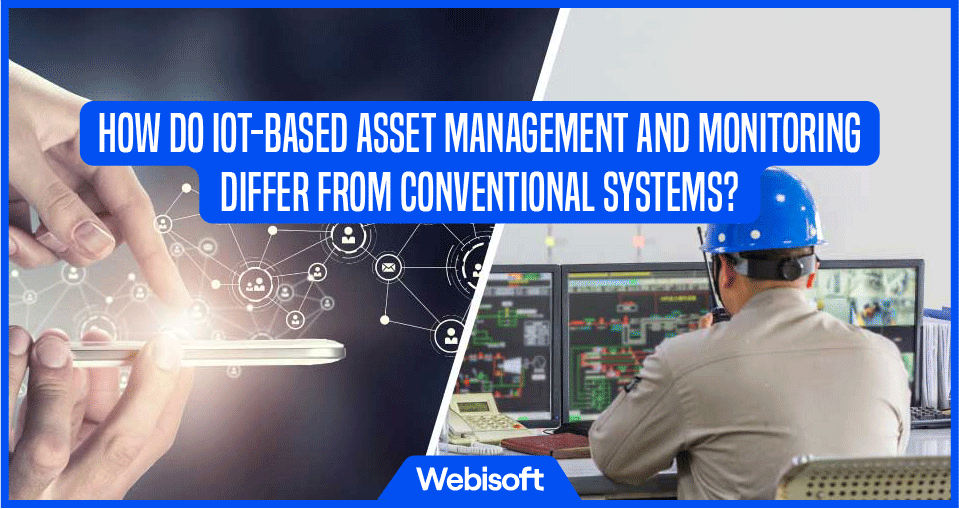
IoT-based asset management and monitoring differ significantly from conventional systems, offering several advantages and capabilities that revolutionize the way assets are managed and monitored. Here is an in-depth exploration of the differences:
- IoT systems enable assets to be connected and communicate with each other and central management systems. This connectivity provides real-time monitoring capabilities, allowing organizations to track asset location, status, performance, and environmental conditions instantaneously. In contrast, conventional systems often rely on manual inspections or periodic updates, which can result in delayed or incomplete information.
- Systems based on IoT collect a vast amount of data from assets using sensors, which are then analyzed to provide valuable insights. Conventional systems cannot typically collect and analyze real-time data comprehensively, limiting the depth and accuracy of insights.
- Asset management that is IoT-based enables predictive maintenance by leveraging real-time data and advanced analytics. In contrast, conventional systems often rely on reactive or preventive maintenance schedules, resulting in either excessive maintenance or unexpected breakdowns.
- IoT systems automate various asset management processes, reducing the need for manual interventions. For example, tasks such as inventory management, asset tracking, and data collection can be automated, minimizing human effort and errors. Conventional systems usually involve manual processes that are time-consuming, labor-intensive, and prone to inaccuracies.
- The Internet of Things enables remote monitoring and control of assets regardless of their physical location. In contrast, conventional systems often require physical presence for inspections, control, or troubleshooting, resulting in delays and limited accessibility.
- IoT-based systems offer scalability and flexibility, allowing organizations to expand their asset monitoring capabilities effortlessly. Conventional systems may require significant modifications or infrastructure changes to accommodate new assets or scaling requirements.
What Are the Specific IoT Components That Enhance Asset Tracking and Monitoring Processes?
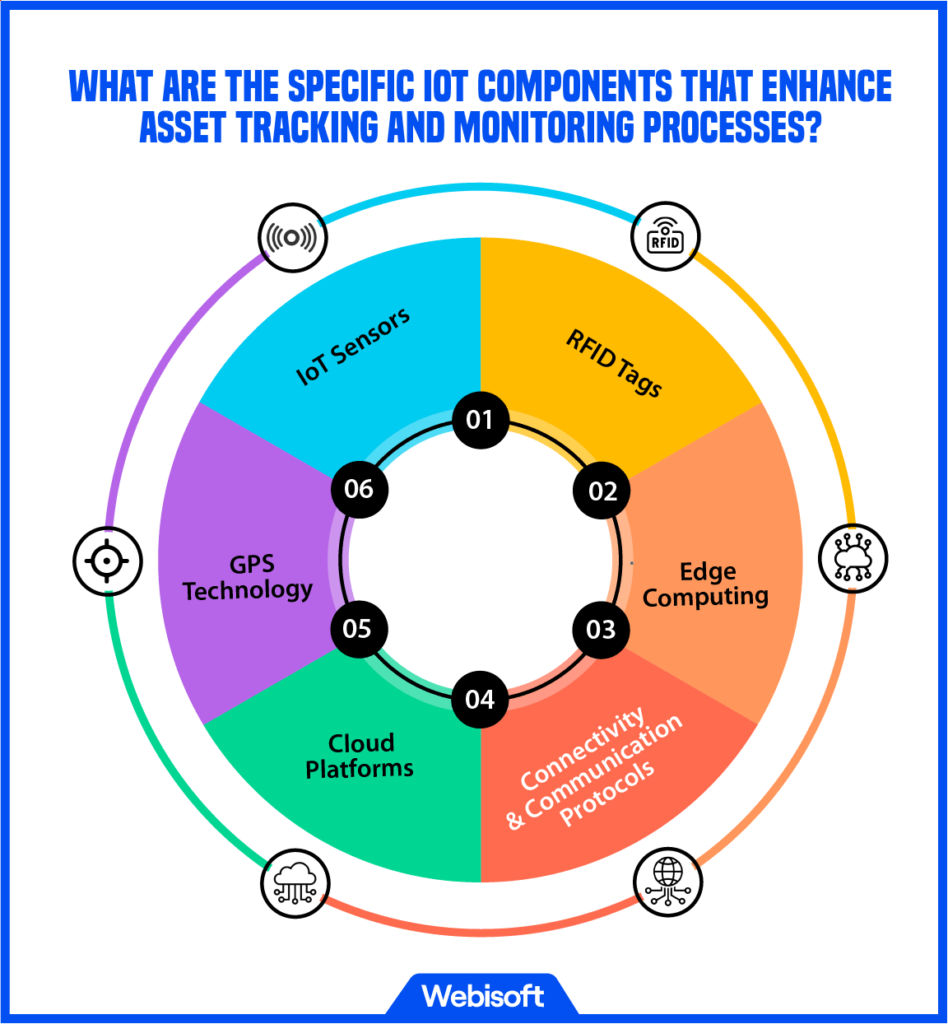
Specific IoT components play a pivotal role in enhancing asset tracking and monitoring processes. These components leverage connectivity, sensors, and advanced technologies to capture and transmit valuable data about assets. Here are some key IoT components that contribute to the effectiveness of asset tracking and monitoring:
IoT Sensors: Sensors are fundamental components of IoT systems. They are embedded in assets or deployed in the surrounding environment to collect data on various parameters such as location, temperature, humidity, vibration, or energy consumption.
RFID Tags: Radio Frequency Identification (RFID) tags are small devices that use radio waves to identify and track assets. They consist of an integrated circuit and an antenna, which enables them to transmit asset-specific information to RFID readers. RFID technology enhances asset tracking by automating identification, reducing manual efforts, and improving accuracy.
GPS Technology: Global Positioning System (GPS) is widely used for asset tracking. GPS-enabled devices, such as trackers or receivers, utilize satellite signals to determine the precise location of assets.
Connectivity and Communication Protocols: IoT relies on connectivity technologies like Wi-Fi, cellular networks, or Low-Power Wide-Area Networks (LPWAN) to establish communication between assets and the central management system. These protocols enable seamless data transmission, facilitating real-time monitoring, and enabling remote access to asset information.
Edge Computing: Edge computing involves processing data closer to the source or the “edge” of the network, rather than sending it to a centralized cloud server. This approach enhances asset tracking and monitoring.
Cloud Platforms: Cloud-based platforms provide storage, processing, and analysis capabilities for the vast amount of data generated by IoT devices. These platforms enable scalable storage, real-time analytics, and data visualization.
How Does an IoT-enabled Asset Management and Monitoring Solution Work?
An IoT-enabled asset management and monitoring solution can transform asset management by leveraging IoT technologies to enhance visibility, control, and efficiency in managing various assets. Here’s a breakdown of how it works:
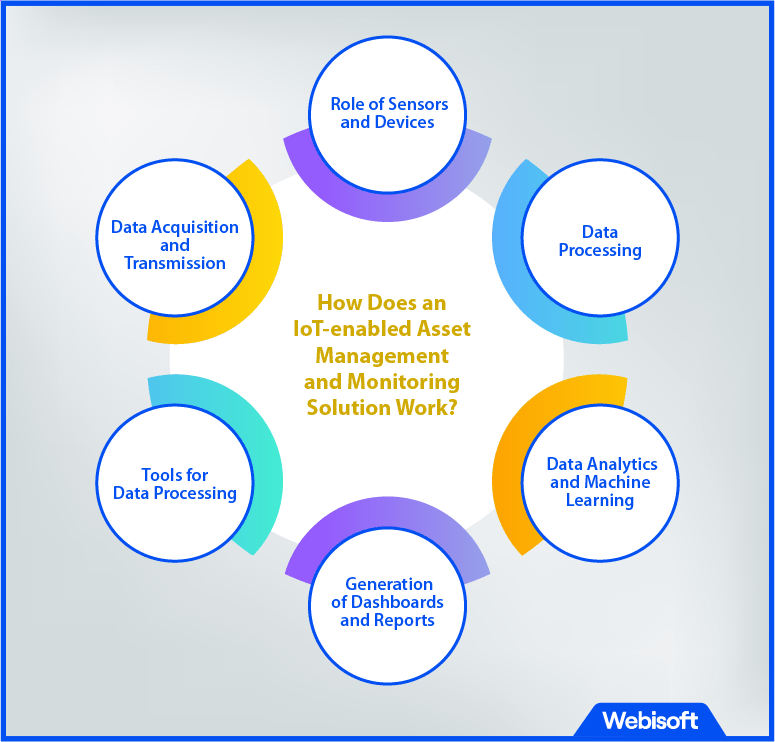
1. Data Acquisition and Transmission: Sensors collect environmental data and send it to the cloud via an intermediary device. The device preprocesses and analyzes the data before transmitting it, acting as a control unit for the sensors.
2. Role of Sensors and Devices: Sensors measure parameters like temperature and light, while devices control the sensors and perform preprocessing tasks. Devices collect sensor data, preprocess it, and transmit it to the cloud as state information (current status) and telemetry (read-only data).
3. Data Processing: The cloud receives messages from connected devices and publishes them for subscribers to read. Data pipelines are established using tools like Beam pipelines, enabling the processing of data and storing it in platforms such as BigQuery, BigTable, or Cloud Storage.
4. Tools for Data Processing: The device manager registers and configures devices, communication protocols facilitate device-to-cloud communication, serverless functions perform actions triggered by events, and Beam pipelines optimize data workflows for large-scale processing.
5. Data Analytics and Machine Learning: Processed data is analyzed in the cloud to generate actionable insights. ML models detect anomalies, while data warehousing tools like AWS Redshift or GCP BigQuery store and query data for analysis, combining historical and real-time data.
6. Generation of Dashboards and Reports: Insights are transformed into customizable reports and dashboards for effective asset management. Tools like Google Datastudio, Kibana, or Tableau convert data into informative visualizations.
What Are the Primary Benefits and Advantages of Implementing IoT in Asset Management and Monitoring Practices?
Implementing IoT in asset management and monitoring practices offers a range of primary benefits and advantages. Here’s an overview of how IoT can transform asset management and the advantages it brings:
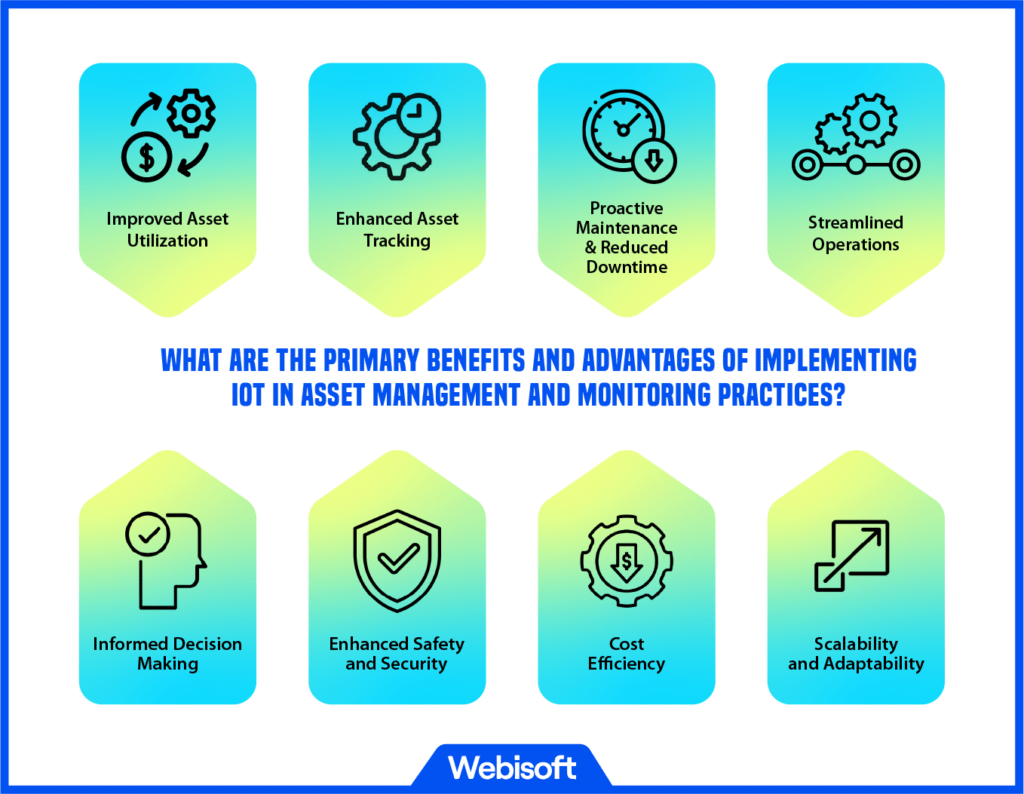
1. Improved Asset Utilization: IoT allows your business to track your assets in real time, giving you a clear understanding of where assets are located and their current condition. This information helps optimize your asset usage.
2. Enhanced Asset Tracking: With IoT, your company can easily track its assets using technologies like GPS or RFID. This enables your business to quickly locate assets if they are misplaced or stolen, reducing the risk of loss.
3. Proactive Maintenance and Reduced Downtime: IoT enables proactive maintenance by continuously monitoring asset performance and detecting potential issues. By identifying problems early, your business can schedule maintenance activities in advance, preventing unexpected breakdowns.
4. Streamlined Operations: IoT automates manual tasks and simplifies processes, leading to smoother operations. Real-time data collection and automated alerts allow your business to stay informed about asset status and take timely action.
5. Informed Decision Making: By harnessing the power of IoT-generated data, your business can make informed decisions regarding asset utilization, maintenance planning, and resource allocation.
6. Enhanced Safety and Security: IoT-based solutions enhance asset safety and security through features such as remote access control, video surveillance, and alarm systems. These measures help protect your assets from theft, unauthorized access, or damage.
7. Cost Efficiency: IoT-based asset management optimizes costs by extending the lifespan of your assets through proactive maintenance, reducing unnecessary replacements. By efficiently managing asset lifecycles and allocating resources based on data-driven insights, your business can minimize expenses.
8. Scalability and Adaptability: IoT solutions are scalable and adaptable, allowing your businesses to easily accommodate growing numbers of assets and adjust to changing requirements.
What Are Some Notable Applications of IoT in Asset Management and Monitoring Across Different Industries?
IoT technology offers significant improvements in asset maintenance, utilization, and resource allocation across various industries. Here’s a breakdown of its applications in different sectors:
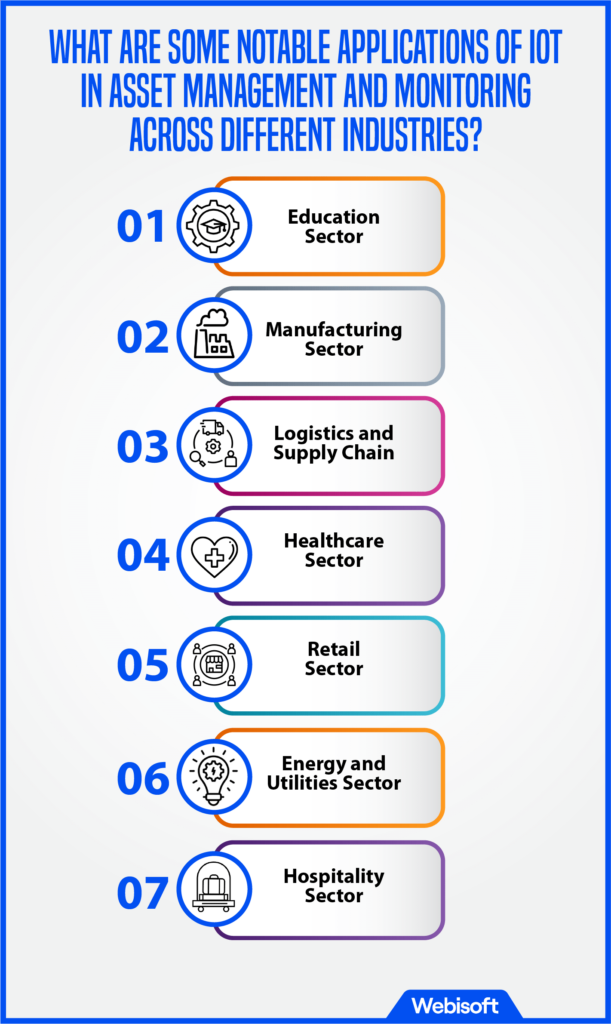
Education Sector
- IoT enables real-time monitoring of equipment, such as projectors, computers, or HVAC systems, allowing educational institutions to detect and address maintenance issues promptly, ensuring uninterrupted operations.
- Systems based on IoT track the usage of classrooms, libraries, or laboratories, helping optimize space utilization and resource allocation based on actual demand.
- By analyzing data on student attendance, energy consumption, and facility usage, IoT assists educational institutions in making informed decisions on resource allocation, such as scheduling classes, managing staff, or optimizing energy usage.
Manufacturing Sector
- IoT sensors embedded in machinery can collect real-time data on performance and condition, enabling predictive maintenance to prevent unexpected breakdowns and minimize downtime.
- The Internet of Things allows manufacturers to monitor equipment utilization, identify idle or underutilized assets,
- IoT systems provide insights into production processes, inventory levels, and supply chain operations, helping manufacturers allocate resources efficiently, streamline workflows, and improve overall productivity.
Logistics and Supply Chain
- The Internet of Things enables remote monitoring of vehicles, tracking parameters like fuel consumption, engine performance, and maintenance requirements, ensuring timely servicing and reducing the risk of unexpected failures.
- IoT-powered asset tracking solutions allow logistics companies to monitor the location, status, and condition of goods and vehicles, optimizing asset utilization, reducing idle time, and improving delivery efficiency.
- IoT provides real-time visibility into inventory levels, shipment status, and demand patterns, allowing logistics companies to allocate resources effectively, plan routes, and streamline operations, resulting in cost savings and improved customer satisfaction.
Healthcare Sector
- IoT devices can monitor medical equipment and instruments, and alert healthcare providers to maintenance needs or potential failures, ensuring the availability and reliability of critical assets.
- Solutions with IoT can optimize the utilization of hospital beds, medical devices, and resources by monitoring occupancy rates, usage patterns, and patient flow, allowing for efficient resource allocation and improved patient care.
- IoT-enabled systems can track and manage inventory levels of medical supplies, medications, and equipment, ensuring optimal resource allocation, reducing waste, and enhancing operational efficiency in healthcare facilities.
Retail Sector
- IoT-enabled sensors can monitor the performance and condition of refrigeration units, ensuring optimal temperature control and reducing the risk of product spoilage.
- Systems based on IoT track in-store foot traffic and customer behavior, helping retailers optimize store layouts, product placements, and staffing levels to improve customer experience and increase sales.
- IoT provides real-time inventory tracking, enabling retailers to manage stock levels efficiently, prevent stockouts, and streamline supply chain operations for improved resource allocation.
Energy and Utilities Sector
- IoT sensors can monitor energy infrastructure such as power grids, transformers, or pipelines, providing real-time data on performance and identifying potential maintenance needs to minimize downtime and improve reliability.
- The Internet of Things enables the monitoring and control of energy usage, allowing utilities to optimize resource allocation, balance energy supply and demand, and improve energy efficiency.
- IoT-based systems help utilities analyze data on energy consumption patterns, grid loads, and demand fluctuations, enabling effective resource allocation, grid management, and planning for future energy needs.
Hospitality Sector
- IoT can monitor and track the maintenance needs of hotel facilities, such as HVAC systems, lighting, or security systems, ensuring guest comfort, safety, and operational efficiency.
- Solutions based on IoT enable hoteliers to optimize room occupancy rates, manage reservations, and track guest preferences, allowing for efficient room allocation and personalized services.
- IoT systems provide insights into energy consumption, water usage, and guest occupancy, assisting in resource allocation, sustainability initiatives, and cost optimization in hospitality operations.
How does IoT Technology Improve Asset Maintenance, Utilization, and Resource Allocation?
IoT technology, which stands for Internet of Things, is all about connecting everyday objects to the Internet. It’s like giving them a way to talk to each other and us humans. This technology has some really cool benefits when it comes to taking care of things we own, making sure they are being used effectively, and using our resources wisely.
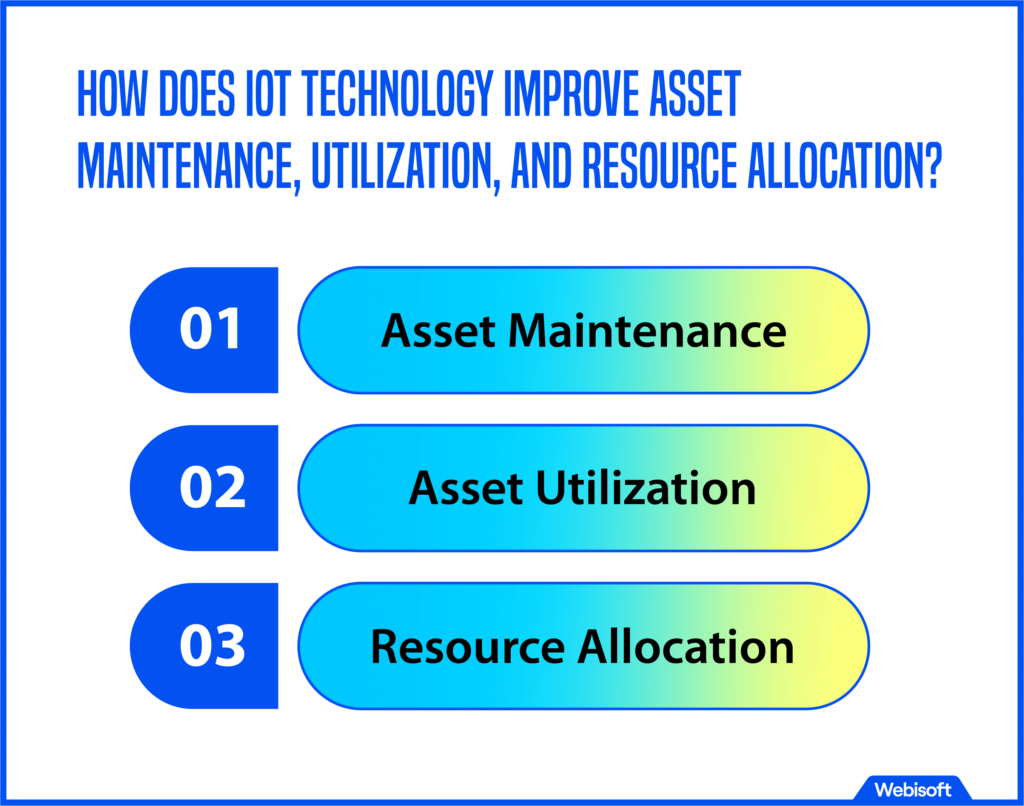
Asset Maintenance
One area where IoT technology really shines is asset maintenance. An asset is something valuable that a person or a company owns, like a machine or a vehicle. With IoT, these assets can be equipped with special sensors and devices that constantly gather data about their condition.
For example, let’s say you have a machine in a factory. IoT sensors can keep an eye on things like temperature, vibration, and performance. If anything goes wrong or if maintenance is needed, the sensors can send alerts to the people in charge. This helps prevent bigger problems and allows maintenance to be done before things break down completely.
Asset Utilization
IoT technology also helps with asset utilization. This means making sure that our assets are being used to their full potential. Let’s take a fleet of delivery trucks as an example. By installing IoT devices in these trucks, we can track their location, speed, and even the condition of the goods they are carrying.
This information can be used to optimize routes, improve delivery schedules, and make sure that the trucks are being used efficiently.
Resource Allocation
IoT technology also helps with resource allocation. Resources can be things like energy, water, or even human labor. With IoT devices, we can monitor and control the usage of these resources more efficiently.
For instance, in a smart home, IoT-connected thermostats can adjust the temperature based on occupancy and weather conditions, saving energy and reducing costs. In industries, IoT sensors can track the usage of machinery and equipment, allowing companies to allocate resources more effectively and avoid wastage.
How Can Organizations Adopt IoT Advancements to Streamline Their Asset Management and Monitoring?
Organizations can use IoT (Internet of Things) technology to make their asset management and monitoring more efficient. To adopt IoT advancements, organizations can follow these steps:
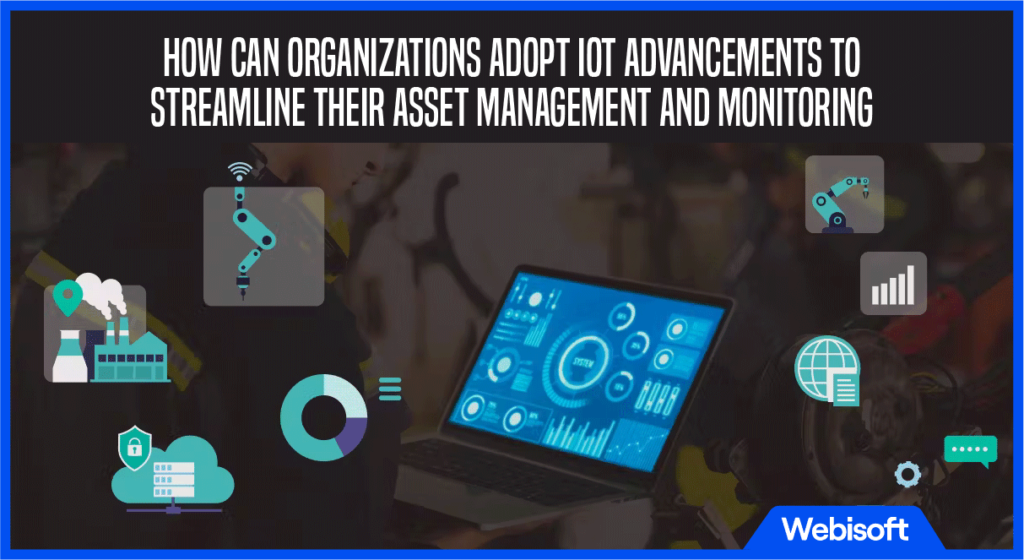
Connectivity: Your organization can utilize IoT technology to connect its assets, such as machinery, vehicles, or equipment, to the internet, enabling them to communicate and share important information.
Sensor Integration: By installing sensors on assets, your organization can gather data on performance, condition, and usage. These sensors can measure factors like temperature, pressure, or location.
Real-Time Monitoring: Through IoT devices, your organization can receive real-time updates on asset status and performance, allowing them to remotely monitor their assets.
Predictive Maintenance: Leveraging IoT data, your organization can predict when maintenance is needed for its assets. This proactive approach helps prevent breakdowns and reduces costly downtime.
Data-Driven Decision-Making: Analyzing the data collected from IoT devices provides valuable insights into asset utilization and performance. These insights inform decision-making processes, such as optimizing asset allocation and scheduling maintenance.
Automation and Control: Utilizing IoT technology, your organization can automate asset management tasks, such as scheduling maintenance or adjusting settings based on predefined conditions. This reduces manual effort and improves operational efficiency.
Resource Optimization: IoT-enabled asset monitoring enables organizations to allocate resources, such as energy, materials, or labor, more effectively. Real-time demand and usage data help optimize resource allocation and minimize waste.
Security Measures: Implementing robust security measures protects IoT-enabled assets and the data they generate, ensuring their safety from cyber threats.
Introducing Websoft: Your Solution for IoT Development
Webisoft is a leading technology company that specializes in providing innovative solutions to businesses across various industries. With a strong focus on cutting-edge technologies and a customer-centric approach, Webisoft aims to empower organizations by leveraging the latest advancements in software development, IoT, AI, and more.
Webisoft can help you adopt IoT advancements in the following way:
1. Customized Development: Webisoft offers tailored IoT development services to meet your specific business needs.
2. Seamless Integration: They have expertise in integrating IoT solutions with your existing infrastructure and software applications for seamless connectivity and interoperability.
3. Robust Security: Webisoft prioritizes security throughout the development process, implementing industry best practices to protect your data, infrastructure, and customer privacy.
4. Ongoing Support and Maintenance: Webisoft offers continuous support, monitoring, and troubleshooting services to ensure smooth operations of your IoT infrastructure.
By partnering with Webisoft, you can effectively harness the power of IoT technologies to transform your operations, improve efficiency, and unlock new business opportunities.
Final Thoughts
In summary, IoT technology is dramatically transforming asset management, ushering in a new era of digital efficiency. By linking assets to the internet, businesses can harness real-time data for informed decision-making, proactive maintenance, and optimized resource allocation, thus reducing downtime and boosting operational efficacy.
Furthermore, IoT-powered automation and data-centric insights amplify decision-making capabilities, enabling businesses to deploy resources effectively and concentrate on strategic agendas. The integration of IoT into asset management propels enterprises into the future, assuring competitive standing in the ever-evolving digital environment. We’re now in the age of IoT-guided asset management, presenting limitless opportunities for efficiency and prosperity.
Are you prepared to embrace the potential of IoT for your asset management? At Webisoft, we’re ready to guide your transformation. Reach out to us today to begin your journey towards streamlined, IoT-enhanced asset management.
